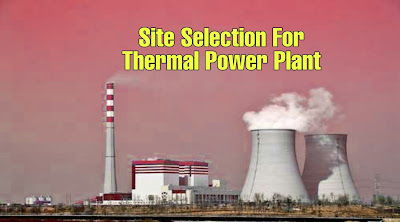Site Selection For Thermal Power Plant
There are some factors must be considered for site selection for thermal power plant which is mentioned below:
2.Nature of land and its cost
3.Availability of water
4.Load centre
5.Transport facilities
6.Availability of labour
7.Ash disposal facilities
8.Future expansion
9.Pollution
10.Away from air fields
 |
| Site Selection For Thermal Power Plant |
1.Availability of raw material
2.Nature of land and its cost
3.Availability of water
4.Load centre
5.Transport facilities
6.Availability of labour
7.Ash disposal facilities
8.Future expansion
9.Pollution
10.Away from air fields
Detail Description of all the factors must be described below:
1. Availability of raw material:
Modern steam power plants using coal or oil as fuel require very large amount or fuel per annum.
On rough estimates, a steam power plant of 300 MW capacity requires about 3000 tonnes of coal per day.
Therefore, it is necessary to locate the plant as far as possible near the coal fields to reduce the cost of transportation of fuel.
If the plant is located away from coal fields it may create problems due to failure of transportation system, strike in mines etc.
For above reasons, atleast 15 days coal supply is needed to be stored at site. It results into:
(a) Increased space requirement
(b) Increased investment
(c) Additional staff requirement
(d) Losses in storage
In case it is not possible to locate the plant near the coal fields then it must be located near the railway station to reduce the cost of road transportation cost from railway station to site of power plant.
2. Nature of land and its cost:
The site selected should have high bearing capacity of at least 10 N/mm^2 to withstand dead load of the plant.It would reduce the cost of foundation of the plant.
Total space required is 1500 - 2500 m per MW capacity of plant including the space required for coal storage and ash handling system.
Therefore, the land cost must be reasonable to reduce its capital cost.
To reduce the civil engineering cost,the land selected should not need much leveling of site such that it should not require filling or blasting.
And also, the site selected should not have any mineral deposits.
3. Availability of water:
Steam plants use water as working fluid which is repeatedly evaporated and condensed. It also needs about 2% of steam generated as make up water due to its loss.
Also,considerable amount of water is needed for condensing the steam in condenser.
On rough estimates it requires about 18 x 10^8 litres of water per day for a 300 MW capacity plant and 36 x 10^6 litres of water as make up water.
Thus, it is necessary to locate a thermal power plant near a place where required quantity of
water is available throughout the year such that near a river, sea or lake.
water is available throughout the year such that near a river, sea or lake.
4. Load centre:
A power plant must be located near the load to which the power is supplied. However,it is not possible to locate the power plant near all the loads.
As such the Centre of Gravity of all the loads is determined with reference to reference axis where the plant is usually located.
The location of power plant at Centre of gravity of loads reduces the cost of transmission lines
and the losses occurring in it. It should also take into account the future developments while selecting the load centre.
and the losses occurring in it. It should also take into account the future developments while selecting the load centre.
5. Transport facilities:
The power plant should be located where the adequate transport facilities are available for transportation of fuel and heavy machinery for installation.
6. Availability of labour:
The Large enough men power is needed during the construction of plant. So labour should be available near the construction site at cheap cost.
7. Ash disposal facilities:
Huge amount of hot ash comes out of the coal based thermal power plants which is hazardous to human and plant life.
It is corrosive and polluting in nature. Therefore, there must be sufficient space and facilities available to dispose of large quantity of ash.
8. Future expansion:
selected site should be such that it allows economic extensions of the plant with the estimated growth of load.
9. Pollution:
The thermal power plants should be located away so as to avoid any nuisance from smoke, fly ash, noise and heat discharged from the plant.
10. Away from air fields:
The power plant should be located away from the densely populated and industrial area by taking into account the aerial warfare.

Comments
Post a Comment